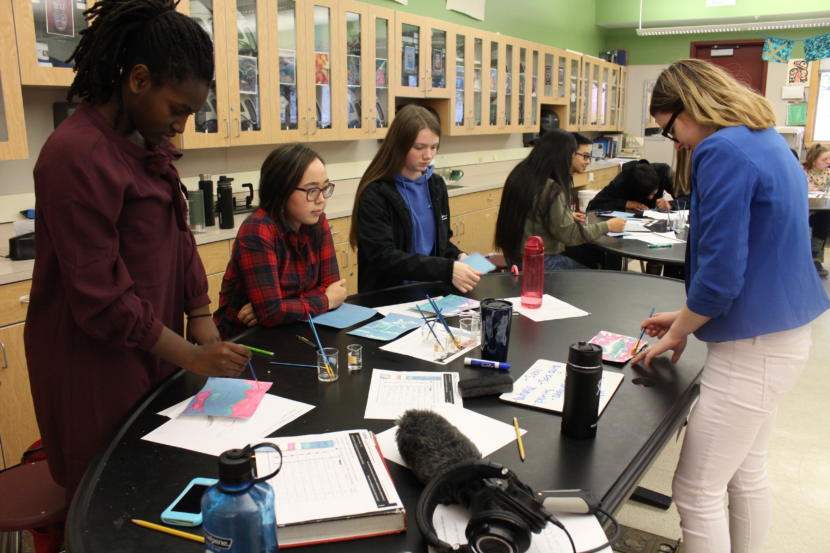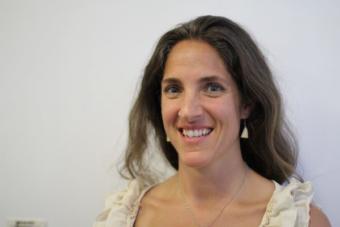
The Alaska Department of Education and Early Development is in the process of revamping its science standards. It hopes to have a draft released by March. But for the past 13 years, teachers have been working with a curriculum that gives little guidance on how to explain the science behind one of Alaska’s most pressing problems: climate change.
Some school districts don’t elaborate on the cause at all. While others are using a growing national model, which makes it clear: Humans are largely to blame.
This week, we’re going inside two Alaska classrooms to learn how teachers and students are navigating these difficult conversations.
Chohla Moll’s classroom at Mt. Edgecumbe High School has an ocean view, and today the proximity to seawater will come in handy.
As the teens settle into their desks, Moll asks them a question.
“So how many of you guys are fisherman (or) fisherwomen?”
Hands shoot up in the air. It’s about half of the class.
The 400-plus students who attend Mt. Edgecumbe, a public boarding school, represent communities from all across the state. Preference is given to those who apply from rural Alaska.
Moll knows how to tap into something that unites all her students when she’s teaching about climate change.
“So what critters at home are going to be affected?” she asks.
Moll has the class make a list of food they like to eat. On a whiteboard, a teenager from Tununak writes clams, walrus and beluga whale.
And Moll has her students consider something else: The ecosystem of these cherished food sources is being disrupted by human activity.
To demonstrate that point, Moll passes around a glass of seawater collected from outside.
The students take turns blowing into it with straws, adding carbon dioxide with their breath.
Thanks to a pH indicator, the classroom can see the chemistry of the water changing right before their eyes. The color transforms from emerald to a light green, indicating the water is becoming increasingly acidic — and that’s exactly what’s happening to the ocean, with the burning of fossil fuels.
Over time, ocean acidification can dissolve the shells of crabs and clams, important marine species that animals and people — and this classroom — like to eat.
Not all teachers in Alaska are this straightforward about how humans are contributing to the problem.
Despite the overwhelming scientific consensus, climate change is still treated as a controversial topic in some places.
Moll says that’s misleading.
“When we come into science, we’re not talking about things that we believe in,” Moll says. “We’re talking about things that we have evidence to back up.”
This is the kind of thinking you’d expect from a daughter raised by two science teachers.
Moll jokes she was initially reluctant to get into the family business. She wanted to do scientific field work, not teach about it. But she missed having conversations.
“And I’m a talker. So I kind of succumbed,” she says with a laugh.
Moll has been talking to students at Mt. Edgecumbe about climate change for 12 years.

Back when she was a student herself in the late 1990s, she says climate change wasn’t part of the curriculum. She learned about the effects of warming from conversations around the dinner table.
Of course, scientists know more now. Predictions with climate modeling have gotten better. We’re starting to see the consequences play out in real time. Last year was one of Alaska’s five warmest on record.
But some public schools still haven’t thawed to the idea of teaching about it.
“There’s really very solid evidence that shows it’s human-driven,” Moll says. “But I still think that, especially in a state that is very supported by fossil fuels, it’s still a fine line that people feel like they have to walk.”
Moll feels empowered to walk that line because her school district is using growing national science standards, where humanity’s contribution to climate change is clearly spelled out. Next Generation Science Standards are more detailed than the ones currently outlined by the state.
Moll even keeps a laminated copy taped to her desk.
“It says it right there: ‘human impact,'” Moll says, gesturing to the standards. “So I feel pretty comfortable about what I’m doing in my classes with my students.”
Moll says she feels like her school district has her back. But she understands why teachers from other districts might be nervous explaining the topic.
For example, the Juneau School District adopted these same national standards last year. But it wouldn’t commit to taking a hard line on climate change attribution. It advised teachers to stick to the line “climate change is happening” and allow students to form their own opinions.
And this tension has played out in other states. As states’ departments of education update their science standards, the language surrounding subjects like climate change or evolution gets edited out or watered down.
Soon, Alaska’s Department of Education will release a draft of its updated science standards. It’s considering modeling those after the national standards that are explicit about climate change. Gov. Michael Dunleavy’s administration is currently reviewing the material.
Moll hopes the new state standards make it clear: Yes, humans are contributing to the problem, and teachers can have these tough conversations.
It’s a talk Moll thinks classrooms in Alaska are ready to hear.
“I really feel like the youth right now, they really want to do something,” Moll says. “They really want their future to be not what’s predicted. And I think science teachers, and teachers in general, can help them kind of formulate that future and change that future. Because it’s their problem.”
Back in class, Moll’s students pick out paint brushes. For today’s final activity, she wants them to paint a picture, reflecting on how environmental change will affect their hometown.
Sixteen-year-old Stephanie Eakin is from Kotzebue. She’s painting a picture of the ocean. Eakin loves to fish, and she says the changes at her doorstep are definitely on her mind.
“Snow is coming later in the year than normal now. The cold, cold weather is coming pretty late,” Eakin says.
But she’s learning what her family is experiencing can be explained by science. She says that makes it easier to understand.
“You start to realize that it’s not just words on the news,” Eakin says. “Like, they’re telling the truth, and you need to start paying attention to it more.”
Eakin thinks that’s the best way to teach kids, maybe even adults: by talking about those lived experiences.
